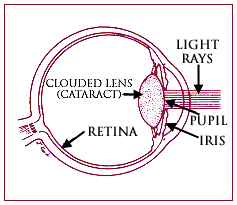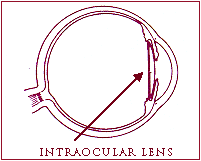What is a cataract?
 A cataract is a clouding of the eye's
natural lens, typically related to age, genetics, and possibly diet or sun exposure.
Cataracts are common in older people. About 60 percent of those older than 60 years and 70 percent of those older than 75 years have cataracts. Because cataracts can seriously impair your vision, they can limit or prevent you from working or enjoying many of the activities that are important to the quality of your life. Fortunately, medical science has made significant strides in cataract treatment. Today, the vast majority of patients whose cataracts are treated surgically enjoy vision that is at least as good as the vision they had before they developed cataracts.
Decreased vision or glare, especially at night, may result from cataract. The rate at which a cataract progresses is highly variable between individuals. When the vision is reduced to the point at which it interferes with activities or bothers the patient, surgical removal may be indicated. Cataract surgery is the most common surgical procedure performed on senior citizens, with over 1 million procedures performed annually in the United States.
A cataract is a clouding of the eye's
natural lens, typically related to age, genetics, and possibly diet or sun exposure.
Cataracts are common in older people. About 60 percent of those older than 60 years and 70 percent of those older than 75 years have cataracts. Because cataracts can seriously impair your vision, they can limit or prevent you from working or enjoying many of the activities that are important to the quality of your life. Fortunately, medical science has made significant strides in cataract treatment. Today, the vast majority of patients whose cataracts are treated surgically enjoy vision that is at least as good as the vision they had before they developed cataracts.
Decreased vision or glare, especially at night, may result from cataract. The rate at which a cataract progresses is highly variable between individuals. When the vision is reduced to the point at which it interferes with activities or bothers the patient, surgical removal may be indicated. Cataract surgery is the most common surgical procedure performed on senior citizens, with over 1 million procedures performed annually in the United States.
The majority of cataracts form later in life as a normal part of the aging
process. Cataracts can develop as a result of injury, eye disease, systemic
problems (such as diabetes), side effects from certain medications, family history (genetics), dietary influences, and sun exposure.
Cataract treatment
A cataract occurs from the denaturing of protein or water intrusion into the natural lens.
Currently, the only effective treatment for cataracts is surgical removal. Medications cannot stop or reverse cataract formation.
With modern medical technology, cataracts are routinely treated safely and effectively using microsurgical techniques. Today, cataract extraction is one of the most successful surgical procedures with over 99% of all cataract surgical procedures resulting in improved vision.
During the early stages of cataract development, more frequent changes in your eyeglass prescription may be sufficient to restore adequate vision. Surgery should be considered when the reduced vision caused by cataracts begins to interfere with normal daily activities such as reading and driving, even when corrective glasses are used. Although the potential risks of surgery must be weighed against its potential benefits, delaying surgery can lead to accidents when driving as well as personal injury such as falls. In addition, the surgical removal of advanced cataracts is more difficult than the removal of less dense cataracts.
If any of the following statements apply to you, you may opt to have cataract surgery:
I do not feel safe driving because of difficulty reading signs, glare from lights at night, or other visual disturbances.
I do not see well enough to do my best at work.
I do not see well enough to do the things I need to do at home.
I do not see well enough to do things I enjoy, such as reading, sewing, or playing golf.
Because of my poor vision, I may bump into things, stumble, or fall.
Because of my poor vision, I am not as independent as I would like to be.
I cannot see as well as I would like to see, even with my glasses.
The modern form of cataract surgery,
called phacoemulsification, utilizes a small (2mm) incision to permit a probe to
enter the cataract and dissolve it using ultrasound energy. The incision is usually self-sealing and usually does not require sutures to close it. This method allows rapid healing and recovery of
vision.
Almost all patients receive an intraocular lens at the time of the surgery to keep the optics of the eye in focus.
Intraocular
Lens (IOL) : A lens implant (intraocular lens or IOL)
is a synthetic clear plastic lens (usually made of acrylic) approximately 6 mm in diameter which is placed
inside the eye  at
the time the cataract is removed. It replaces the natural lens and remains permanently within
the eye. The lens has small spring-like arms called haptics that prevent
the lens from moving out of place.The IOL is placed in the eye during surgery and
replaces the cloudy natural lens. Intraocular lenses have been safely implanted in cataract surgery for over 30 years. The intraocular lens rarely needs to be removed or replaced.
at
the time the cataract is removed. It replaces the natural lens and remains permanently within
the eye. The lens has small spring-like arms called haptics that prevent
the lens from moving out of place.The IOL is placed in the eye during surgery and
replaces the cloudy natural lens. Intraocular lenses have been safely implanted in cataract surgery for over 30 years. The intraocular lens rarely needs to be removed or replaced.